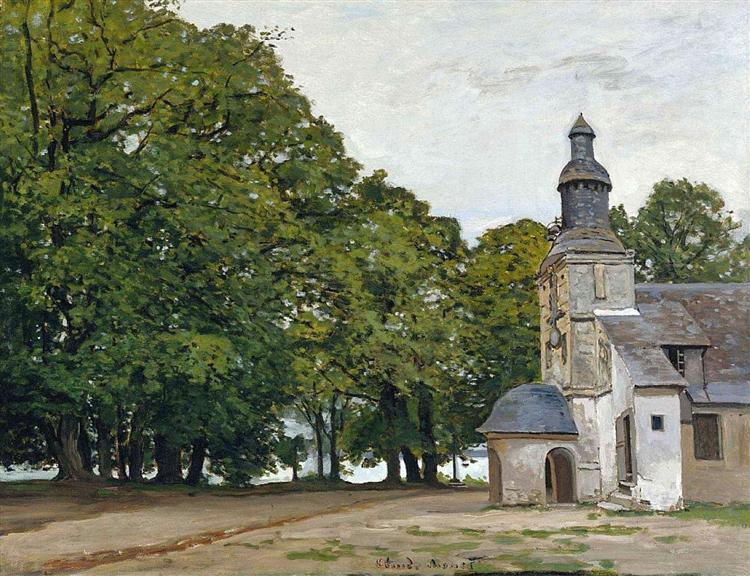Opis
Claude Monet's painting "The Chapel of Notre-Dame de Grâce at Honfleur", painted in 1864, dates from an early stage in the artist's career, during a period that coincides with his explorations of natural landscapes and the depiction of air and light. This work, with its focus on the chapel located on the Normandy coast, reveals not only the painter's devotion to the landscape, but also his talent for capturing atmosphere and environment.
Monet opts for a composition that directs the viewer's gaze to the chapel with its simple architecture, framed by the natural surroundings. The position of the chapel, set slightly to one side, establishes a dialogue between the building and the surrounding landscape. The selection of this specific location also reflects the spiritual and emotional connection the artist felt towards the region, as Honfleur was a familiar place for him, where he spent time and was inspired by the beauty of the surroundings.
The palette used in the work is rich and varied, predominantly in shades of blue and green that evoke the freshness of the maritime landscape, contrasting harmoniously with the earthy tones of the chapel. Touches of yellow light can be seen on the front of the building, suggesting the incidence of the sun on a calm afternoon. Monet demonstrates his mastery in applying the technique of loose and rapid brushstrokes, which would become defining characteristics of Impressionism. This technique not only provides texture, but also allows the viewer to perceive the vibration of light through the colors.
The atmosphere of the scene appears to be serene and contemplative, a feeling that may be accentuated by the absence of human characters in the composition. The lack of a central figure or human activity creates a space in which nature and architecture communicate in an almost poetic way, inviting the viewer to reflect on the environment and the beauty of the place. This focus on the everyday and nature is typical of the Impressionist movement, which sought to capture the essence of fleeting moments.
Furthermore, Monet can be seen to be playing with light and shadow in the painting in a way that foreshadows the experiments he would undertake in his later works. The shadows cast by the chapel and the play of light across the clouds add depth to the scene and suggest a specific time of day. Attention to movement and changes in the weather—another recurring theme in Monet’s work—is also evident here, as the dynamic sky confronts the stability of the chapel with its robust structure.
In the context of art history, this painting by Monet is significant not only for its aesthetic qualities, but also for how it marks a turning point in the development of Impressionism. The artist's ability to synthesize light, color, and landscape into a balanced composition anticipates its later evolution. "The Chapel of Notre-Dame de Grâce at Honfleur" is a testament to how art can connect the viewer with the natural world, expressing the visual experience in a contemporary and emotional way. In short, this work is a beautiful reflection of Monet's transition to a bolder, more experimental style that would influence generations of future artists.
KUADROS ©, a famous painting on your wall.
Hand-made oil painting reproductions, with the quality of professional artists and the distinctive seal of KUADROS ©.
Painting reproduction service with satisfaction guarantee. If you are not completely satisfied with the replica of your painting, we will refund 100% of your money.

